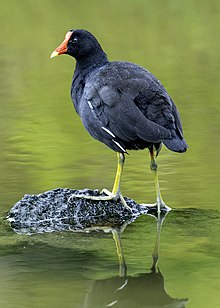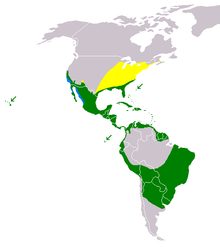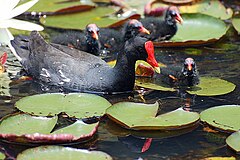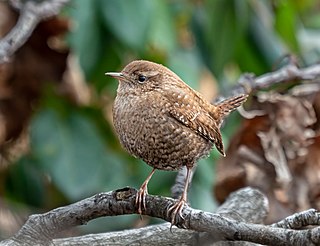
The winter wren is a very small North American bird and a member of the mainly New World wren family Troglodytidae. The species contained the congeneric Pacific wren of western North America and Eurasian wren (Troglodytes troglodytes) of Eurasia until they were split in 2010.

The merlin is a small species of falcon from the Northern Hemisphere, with numerous subspecies throughout North America and Eurasia. A bird of prey once known colloquially as a pigeon hawk in North America, the merlin breeds in the northern Holarctic; some migrate to subtropical and northern tropical regions in winter. Males typically have wingspans of 53–58 centimetres (21–23 in), with females being slightly larger. They are swift fliers and skilled hunters which specialize in preying on small birds in the size range of sparrows to quail. The merlin has for centuries been well regarded as a falconry bird. In recent decades merlin populations in North America have been significantly increasing, with some merlins becoming so well adapted to city life that they forgo migration.

Rails are a large, cosmopolitan family of small- to medium-sized terrestrial and/or semi-amphibious birds. The family exhibits considerable diversity in its forms, and includes such ubiquitous species as the crakes, coots, and gallinule; other rail species are extremely rare or endangered. Many are associated with wetland habitats, some being semi-aquatic like waterfowl, but many more are wading birds or shorebirds. The ideal rail habitats are marsh areas, including rice paddies, and flooded fields or open forest. They are especially fond of dense vegetation for nesting. The rail family is found in every terrestrial habitat with the exception of dry desert, polar or freezing regions, and alpine areas. Members of Rallidae occur on every continent except Antarctica. Numerous unique island species are known.
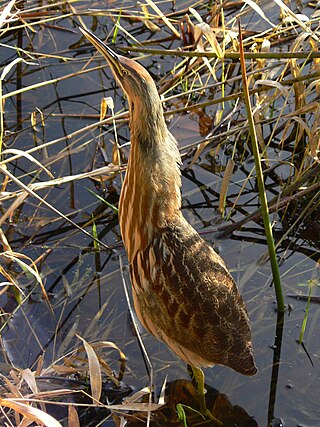
The American bittern is a species of wading bird in the heron family. It has a Nearctic distribution, breeding in Canada and the northern and central parts of the United States, and wintering in the U.S. Gulf Coast states, all of Florida into the Everglades, the Caribbean islands and parts of Central America.

The American teal or green-winged teal is a common and widespread duck that breeds in the northern areas of North America except on the Aleutian Islands. It was considered conspecific with the Eurasian teal for some time, but has since been split into its own species. The American Ornithological Society continues to debate this determination; however, nearly all other authorities consider it distinct based on behavioral, morphological, and molecular evidence. The scientific name is from Latin Anas, "duck" and carolinensis, "of Carolina".

The common moorhen, also known as the waterhen or swamp chicken, is a bird species in the rail family (Rallidae). It is distributed across many parts of the Old World.

The American coot, also known as a mud hen or pouldeau, is a bird of the family Rallidae. Though commonly mistaken for ducks, American coots are only distantly related to ducks, belonging to a separate order. Unlike the webbed feet of ducks, coots have broad, lobed scales on their lower legs and toes that fold back with each step which facilitates walking on dry land. Coots live near water, typically inhabiting wetlands and open water bodies in North America. Groups of coots are called covers or rafts. The oldest known coot lived to be 22 years old.
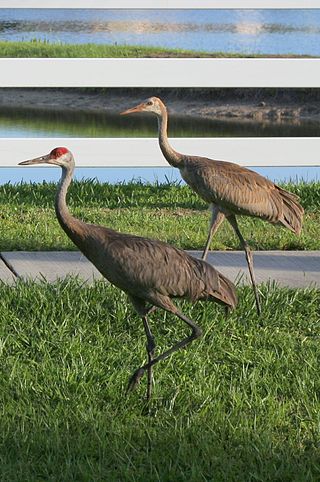
The sandhill crane is a species of large crane of North America and extreme northeastern Siberia. The common name of this bird refers to their habitat such as the Platte River, on the edge of Nebraska's Sandhills on the American Great Plains. Sandhill Cranes are known to frequent the edges of bodies of water. The central Platte River valley in Nebraska is the most important stopover area for the nominotypical subspecies, the great sandhill crane, with up to 450,000 of these birds migrating through annually.

The purple gallinule is a swamphen in the genus Porphyrio. It is in the order Gruiformes, meaning "crane-like", an order which also contains cranes, rails, and crakes. The purple gallinule is a rail species, placing it into the family Rallidae. It is also known locally as the yellow-legged gallinule. The specific name martinica denotes "of Martinique".

The marsh wren is a small North American songbird of the wren family. It is sometimes called the long-billed marsh wren to distinguish it from the sedge wren, also known as the short-billed marsh wren.

Moorhens—sometimes called marsh hens—are medium-sized water birds that are members of the rail family (Rallidae). Most species are placed in the genus Gallinula, Latin for "little hen". They are close relatives of coots. They are often referred to as (black) gallinules. Recently, one of the species of Gallinula was found to have enough differences to form a new genus Paragallinula with the only species being the lesser moorhen.

The dusky moorhen is a bird species in the rail family and is one of the eight extant species in the moorhen genus. It occurs in India, Australia, New Guinea, Borneo and Indonesia. It is often confused with the purple swamphen and the Eurasian coot due to similar appearance and overlapping distributions. They often live alongside birds in the same genus, such as the Tasmanian nativehen and the common moorhen.
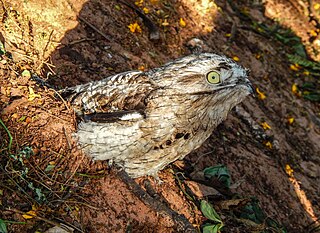
The common potoo, or poor-me-ones, or urutau is one of seven species of birds within the genus Nyctibius. It is notable for its large, yellow eyes and a wide mouth. Potoos are nocturnal and are related to nightjars and frogmouths. They lack the characteristic bristles around the mouths of true nightjars.

The Mexican jay formerly known as the gray-breasted jay, is a New World jay native to the Sierra Madre Oriental, Sierra Madre Occidental, and Central Plateau of Mexico and parts of the southwestern United States. In May 2011, the American Ornithologists' Union voted to split the Mexican jay into two species, one retaining the common name Mexican jay and one called the Transvolcanic jay. The Mexican jay is a medium-sized jay with blue upper parts and pale gray underparts. It resembles the Woodhouse's scrub-jay, but has an unstreaked throat and breast. It feeds largely on acorns and pine nuts, but includes many other plant and animal foods in its diet. It has a cooperative breeding system where the parents are assisted by other birds to raise their young. This is a common species with a wide range and the International Union for Conservation of Nature has rated its conservation status as being of "least concern".

The white hawk is a bird of prey breeding in the tropical New World of the family Accipitridae. Though it is commonly placed in the subfamily Buteoninae, the validity of this group is doubtful and currently under review.

Anser is a waterfowl genus that includes the grey geese and the white geese. It belongs to the true goose and swan subfamily of Anserinae under the family of Anatidae. The genus has a Holarctic distribution, with at least one species breeding in any open, wet habitats in the subarctic and cool temperate regions of the Northern Hemisphere in summer. Some also breed farther south, reaching into warm temperate regions. They mostly migrate south in winter, typically to regions in the temperate zone between the January 0 °C (32 °F) and 5 °C (41 °F) isotherms.

Porphyrio is the swamphen or swamp hen bird genus in the rail family. It includes some smaller species of gallinules which are sometimes separated as genus Porphyrula or united with the gallinules proper in Gallinula. The Porphyrio gallinules are distributed in the warmer regions of the world. The group probably originated in Africa in the Middle Miocene, before spreading across the world in waves from the Late Miocene to Pleistocene.

The Gough moorhen is a medium-sized, almost flightless bird that is similar to the common moorhen, but is smaller, stockier, and has shorter wings. The bird has a distinctive yellow-tipped red bill and red frontal shield. Its first account was written in 1888 by the polar explorer George Comer, whom the specific name comeri commemorates. This bird is found only on two remote islands in the South Atlantic.

William Pierce Brodkorb was an American ornithologist and paleontologist.

The Hawaiian gallinule is an endangered chicken-sized water bird in the rail family. It is also variously known as the Hawaiian common gallinule, Hawaiian moorhen, Hawaiian common moorhen, mudhen, or ‘alae ‘ula in Hawaiian, and sometimes misleadingly as the Hawaiian red coot. It is a subspecies of the common gallinule that is endemic to the tropical Hawaiian Islands of the north-central Pacific Ocean.
